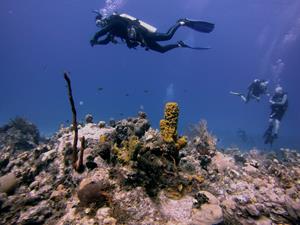![]()
- Back to Bonaire
- It's Time to Renew
- Shark Facts (#4 In the Series)
- 4th Annual Active Divers Dive Cruise
- Active Divers Guide to Shore Diving in Bonaire
- The 2019 Annual Active Divers Dive Cruise is Ready for Booking!
- Neoprene for the Perpetually Cold
- About 2018 Refunds and Credits
- Biofences
- Walker's Cay to Re-Open
- Newsletter Delivery Options
- Email or Address Change?
- T-Shirts For Sale
- Active Divers Guidelines & Policies
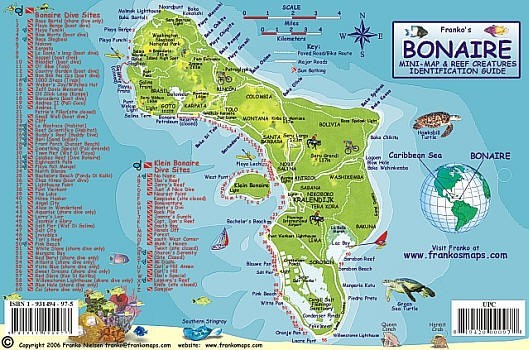
By popular request, next year’s Caribbean dive trip will be to Bonaire, Netherland Antilles on July 20 through 27, 2019. For those who have not been to Bonaire, it’s known as the “Shore Diving Capitol of the World” and once you’ve been there you will know why. The map shows all of the sites and how to get there. There are bright yellow markers along the road with a number on them that indicates which dive site is at that location. That’s why the unlimited shore diving (with nitrox!)Is so important in Bonaire.
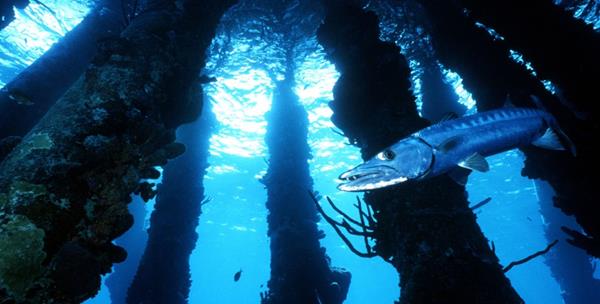 One of my favorite shore dive
sites is the Salt Pier which is where ships dock to load salt that
is produced on the island. The best way to do this dive is as a dusk
entry and then explore as the night time creatures come out.
One of my favorite shore dive
sites is the Salt Pier which is where ships dock to load salt that
is produced on the island. The best way to do this dive is as a dusk
entry and then explore as the night time creatures come out.
After looking over the packages being offered at the DEMA show, this one really stood out as the best value. In Bonaire, like many of the small Caribbean islands, it is very expensive to dine out so this all inclusive resort takes care of that problem since it includes all meals and beverages.We selected the Plaza Beach and Dive Resort, located near Klein Bonaire.
Here is what is included: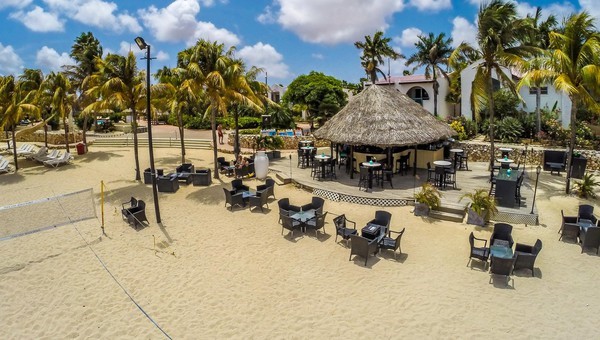
- 7 night Jr Suite Laguna View accommodations
- 12, 1-tank boat dives + unlimited shore diving
- Free Nitrox
- Breakfast, lunch and dinner daily
- Snacks and beverages including house brand alcohol
- Free Wi-Fi
- Scheduled entertainment and use of non-motorized water sports
- Airport transfers, hotel tax and service
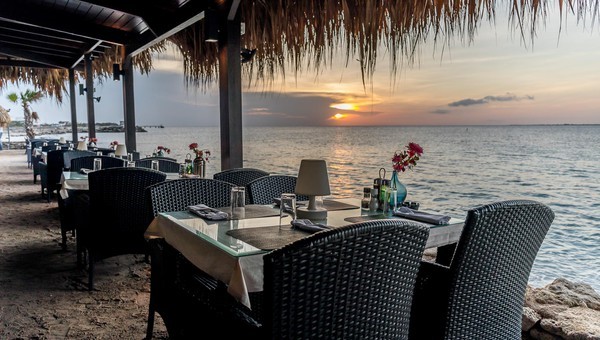 After a full day of diving you can relax and enjoy
your included dinner at the seaside restaurant with your fellow
divers.
After a full day of diving you can relax and enjoy
your included dinner at the seaside restaurant with your fellow
divers.
The cost is $1599 per person, double occupancy. As always, airfare is not included so you can use the carrier of your choice. A $100 deposit is required and final payment will be due by April 1, 2019 via check made out to Active Divers Association and sent to:
Jerry Kosakowski 298 NW 83 Lane Coral Springs FL 33071-7439
Use the convenient button at the bottom of this article to place your deposit and save your spot on this fantastic dive adventure!
![]()
 The clock is counting down and
we are nearing the last chance to renew at a reduced rate. Renew
before March 31, 2019 and your membership fee
is only $35 for a calendar year of discounts and diving news. After
March 31, your annual membership renewal fee is $49.
The clock is counting down and
we are nearing the last chance to renew at a reduced rate. Renew
before March 31, 2019 and your membership fee
is only $35 for a calendar year of discounts and diving news. After
March 31, your annual membership renewal fee is $49.
Your membership includes periodic eNews emails about club activities as well as electronic access to The Mouthpiece monthly newsletter.
Your membership includes periodic eNews emails about club activities as well as electronic access to The Mouthpiece monthly newsletter. You may pay by check or online. Go to https://www.activedivers.site/Membership_Renewal.html to renew your membership online. Instructions for paying by check may be found there as well.
![]()
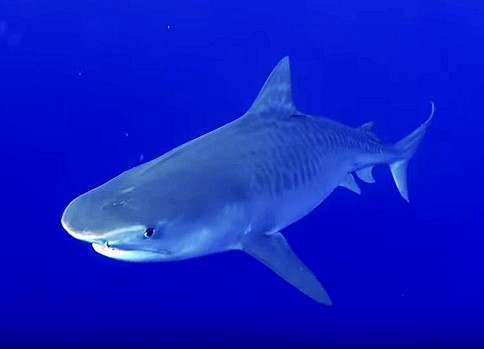
Tiger Shark
It is 1776 and there is an outbreak of suicides aboard slave ships to the colonies. They thought their bodies would be returned to their ancestors. The slave masters had to convince them otherwise. Hence, the shark. The masters tied one slave to a rope and threw him overboard. After awhile they dragged the remains in. Only the ankles and feet remained. This “demonstration” stopped the suicides. The slaves would not be returned to their ancestors after all, at least not using this method, or so they believed. Man can be inhuman.
In the Fiji Islands (some of you well-travelled, may have encountered this) captured large sharks and then had some Indians (after being drugged) kiss the belies of the sharks. This strange custom found its’ way to Fort Lauderdale in the early 60’s. The students were drugged (on alcohol) also. This same initiation rite took place on the beaches, with a shark named “Freddy” (a Tiger Shark) This came to a halt after the police put an end to it (always spoiling the fun).
We also have the Shark-charmers of Ceylon. They used these “special” persons to ward off sharks from their fishermen. Strangely, Sri Lanka remains comparatively safe from sharks. Who knew?
![]()
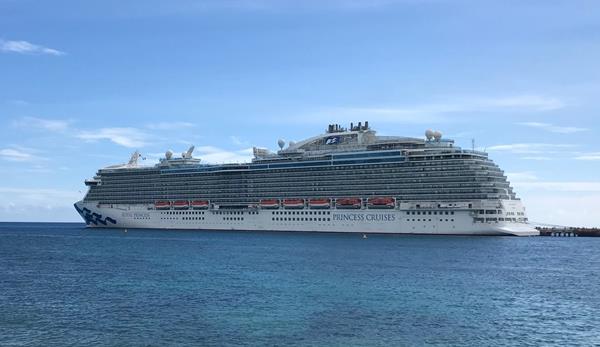 Eleven adventurous Active Divers Club members and their
significant others embarked on the Royal Princess for a week of diving,
adventure, and entertainment. Departing Fort Lauderdale on November 24th
in picture perfect weather, the ship headed south for a day at sea
followed by a day of diving in Grand Cayman on Monday. As we were
tendering in, we used the ship-sponsored excursion and had the dive boat
all to ourselves with Laura and Nick at Cayman Diving Center
right besides the pier. Under bright blue, clear skies we had two
fabulous Grand Cayman reef dives.
Eleven adventurous Active Divers Club members and their
significant others embarked on the Royal Princess for a week of diving,
adventure, and entertainment. Departing Fort Lauderdale on November 24th
in picture perfect weather, the ship headed south for a day at sea
followed by a day of diving in Grand Cayman on Monday. As we were
tendering in, we used the ship-sponsored excursion and had the dive boat
all to ourselves with Laura and Nick at Cayman Diving Center
right besides the pier. Under bright blue, clear skies we had two
fabulous Grand Cayman reef dives.
We were oblivious to the cold weather to the north of us as winter storm Bruce bore done on the Northeastern U.S. and brought chilly weather to south Florida as well. But as temperatures cooled to the high seventies and rain clouds began to darken our skies, we were affected as well.
We landed in Costa Maya at noon on Tuesday and took taxis to the Mar Adentro ("In the Sea") dive shop for our afternoon dive. It had already started to rain as we started our first dive and the rest of the day was rainy, but we still got in two terrific dives. Afterwards we returned to our ship's dry and warm staterooms and enjoyed an exquisite dinner!
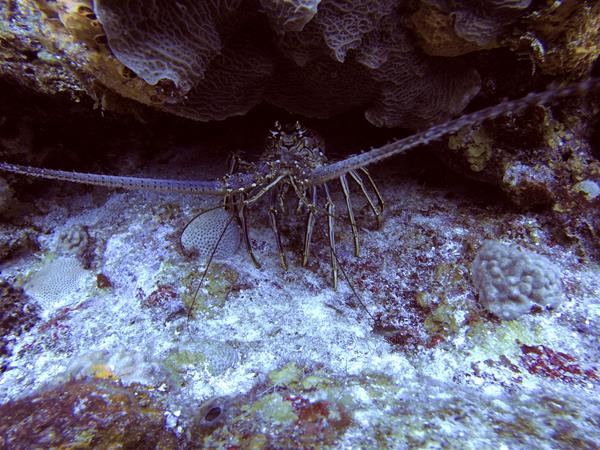 On Wednesday, we
used the ship's excursion in Belize City, which turned out to be a
very convenient arrangement. The dive boat actually docked alongside
the cruise ship so we did not have to tender in to Belize. We just
stepped off the Royal Princess and onto the dive boat. Seas
were a bit rough as we made our way to Turneffe Atoll for our two
dives there. Most everyone agreed that the second dive was the best,
loaded with patch reefs, and prolific with lobsters and other
critters.
On Wednesday, we
used the ship's excursion in Belize City, which turned out to be a
very convenient arrangement. The dive boat actually docked alongside
the cruise ship so we did not have to tender in to Belize. We just
stepped off the Royal Princess and onto the dive boat. Seas
were a bit rough as we made our way to Turneffe Atoll for our two
dives there. Most everyone agreed that the second dive was the best,
loaded with patch reefs, and prolific with lobsters and other
critters.
The weather was forecast to clear as we headed to Cozumel for our final dive day on Thursday, and as we headed to the dive shop there were spots of blue sky showing through the clouds. We boarded the Sand Dollar Express with eleven Active Divers members and three other divers and headed to the reefs. The first dive took us a bit by surprise as it was a screaming south current where Cozumel almost always has a north-running current. The visibility was still 80 feet or so but it was a real fast ride! The second dive was a gentler north current with that awesome deep blue 100-plus foot visibility that makes Cozumel famous. It was one of those dives that you never want to end!
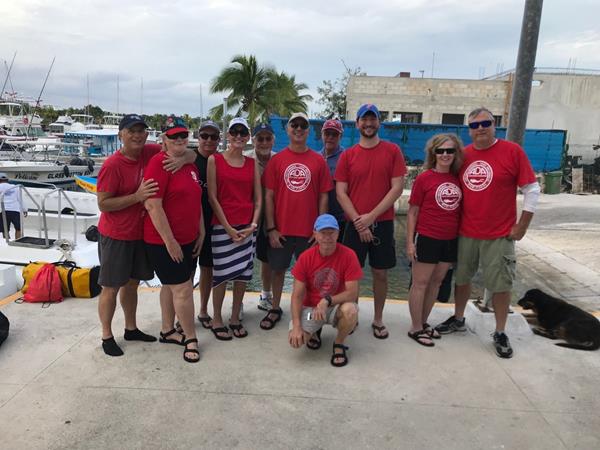 L to R: Tom Workman, Sandy
Workman, Al Menendez, Olivia Baeza, Tony Spagnolo, Dan Baeza,
Daryl Johnson, Frank Clark, Dan Baeza, Jr, Susan Noll, Chris
Noll
L to R: Tom Workman, Sandy
Workman, Al Menendez, Olivia Baeza, Tony Spagnolo, Dan Baeza,
Daryl Johnson, Frank Clark, Dan Baeza, Jr, Susan Noll, Chris
Noll
Cozumel was the only port where all 11 ADA members attended the dive, so we concluded the last dive with a group picture. Look carefully and you will see cruise ships in the background.
.
So here is the dive log for our trip:
11/26 Grand Cayman
- Tunnels: 98 feet, 42 minutes
- Angel Reef: 62 feet, 56 minutes
11/27 Costa Maya
- Staircase: 85 feet, 55 minutes
- 40 Canyons 83 feet, 53 minutes
11/28 Belize
- Mini-Elbow: 73 feet, 53 minutes
- The Playground: 72 feet, 48 minutes
11/29 Cozumel
- Paso del Cedral: 82 feet 36 minutes
- Yucab Reef:58 feet, 50 minutes
All agreed that the trip delivered on great diving, great accommodations, food, and entertainment at a terrific value. I’ve already picked out the 2019 Dive cruise, and it’s going to be even better. So, save the date for December 7 - 14, 2019!
![]()
One of the greatest advantages to our upcoming international dive trip to Bonaire is the plethora of wonderful shore diving sites there. Morning boat dives are part of the package, but seasoned travelers to the diver's paradise island know that the world's best shore diving awaits every day after lunch.
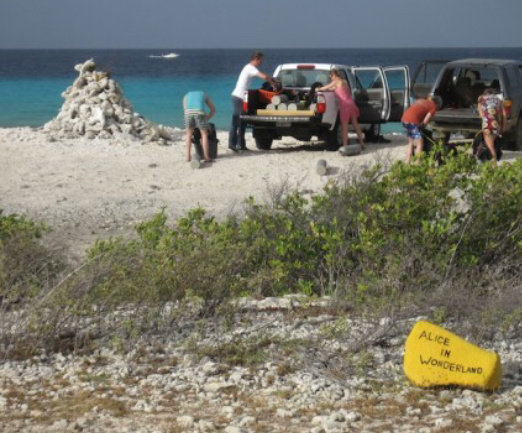
The airport in Bonaire's capitol of Kralendijk rents no-frills stick-shift Toyota pickup trucks that hold five passengers complete with a large open truck bed for dive gear. The resort provides unlimited Nitrox tanks that guests can load into their pickups along with gear to take shore diving. Along the main road on Bonaire's west coast are numerous conspicuous yellow stones with names of various dive sites etched into them. There's even a "diver crossing" road sign near one of the sites! Each stone sign leads to a small parking area with short path leading to the sea. The difference between Bonaire shore diving sites and those found in Florida is that some of the very best dive sites in Bonaire are not necessarily accessed by boat.
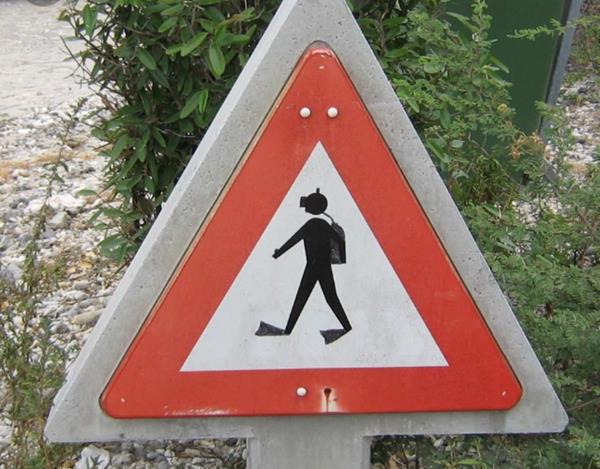
Here's how it works. Load up all tanks, weights and gear for up to five people into the back of the pickup truck. Many dive resorts have a drive-up tank shack specifically designed for this purpose to make it easy to load. Drive along the main road until you find a dive site that you want to try. Suit up and don't worry about locking the truck. Local legend has it that it's best to leave the truck unlocked with all valuables removed (including dive gear) to avoid temptation for break-ins. Some take the key or hide it under a nearby rock - just don't forget which one. The entries are usually short and relatively smooth. Some entries are completely sandy, but it's still a good idea to wear booties just in case. The drop-offs happen quickly, and navigation is relatively easy. Once in the water it's always a good idea to take note of a conspicuous reference point on the shoreline landscape such as a tree, a building, etc. to ensure you come back to the right spot to find your truck. Once in the water, it's always important to take a compass heading as you start out along the reef parallel to the shore and follow the reciprocal compass heading on your way back to the entry point.
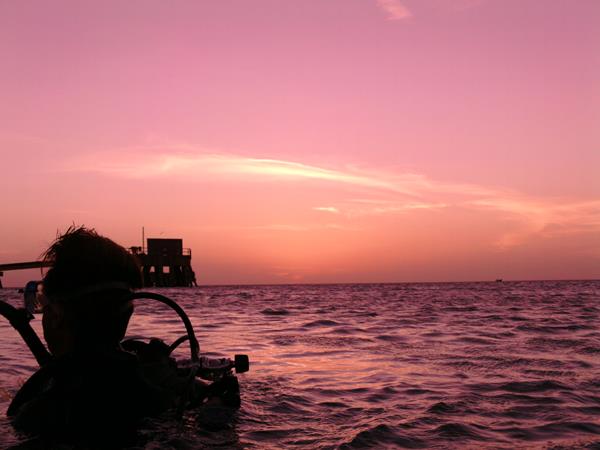
So, if you're on the fence about joining us for Bonaire next year, just know that unforgettable shore diving as you've likely never before experienced is included as part of the package. We are looking very forward to experiencing this again next year!
![]()
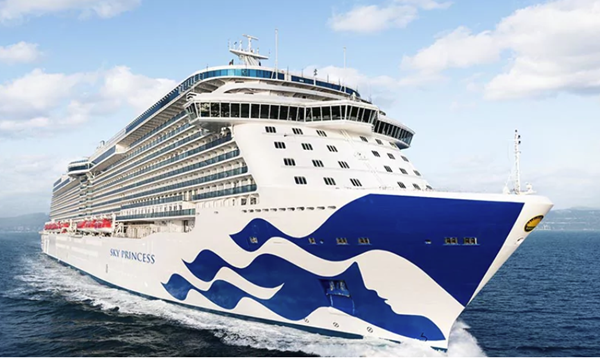 It seems like we just finished a dive cruise, and
now planning has begin for the next one! Bookings are already being
made for next year’s dive cruise since it is such a spectacular
itinerary on the Sky Princess, the largest and newest ship in the
Princess fleet! Its inaugural voyage will take place in October 2019
and it is sure to be a popular ship, so don’t wait too long to lock
in this trip. The dive cruise is a seven-day round trip from Fort
Lauderdale starting on December 7, 2019. It stops at four great dive
locations: Grand Cayman, Roatan, Belize, and Cozumel, and it is on
sale now for as low as $784. That’s only $112 per person, per day
for your lodging, transportation, entertainment and all the food you
can eat. Try and match that price any other way you can to get to
all these dive destinations!!! This is going to be a very popular
cruise since it is on a new ship, so I don’t expect much in the way
of bargains as we get closer to the departure date. The low price
balcony cabins are already sold out!
It seems like we just finished a dive cruise, and
now planning has begin for the next one! Bookings are already being
made for next year’s dive cruise since it is such a spectacular
itinerary on the Sky Princess, the largest and newest ship in the
Princess fleet! Its inaugural voyage will take place in October 2019
and it is sure to be a popular ship, so don’t wait too long to lock
in this trip. The dive cruise is a seven-day round trip from Fort
Lauderdale starting on December 7, 2019. It stops at four great dive
locations: Grand Cayman, Roatan, Belize, and Cozumel, and it is on
sale now for as low as $784. That’s only $112 per person, per day
for your lodging, transportation, entertainment and all the food you
can eat. Try and match that price any other way you can to get to
all these dive destinations!!! This is going to be a very popular
cruise since it is on a new ship, so I don’t expect much in the way
of bargains as we get closer to the departure date. The low price
balcony cabins are already sold out!
So how easy is it to book the fifth annual dive cruise in 2019?? All you have to do is call our Cruise Planner, Karen Bradder at 1-800-901-1172 extension 41643, and tell her that you want to book the Active Divers cruise and make a deposit. That’s it, no muss, no fuss and you will be ready for an outstanding trip with ADA!!
See you onboard!
![]()
Winter is coming! For native Floridians, long-term residents, and just plain divers who get cold in the water, diving after November requires a full wetsuit, including, hood, gloves, and booties. The material of choice is neoprene and while all neoprene share some similarities, not all neoprene is manufactured equally. For starters, neoprene was developed by DuPont in 1930 as a synthetic cheaper substitute for rubber, which had become quite expensive, under the marketing name DuPrene. Later, the name was changed to neoprene to indicate that neoprene was merely a material that could be used in the manufacture of synthetic rubber products.
Chemically, neoprene is a polychloroprene or long-chain molecule
made up of chloroprene monomers. Most neoprene is manufactured from
petroleum in a two-step process beyond the scope of this article. As
with anything manufactured using petroleum, there is a deleterious
environmental impact. A second method uses crushed limestone. While
not as impactful, there is still an environmental cost for mining
limestone rock and in the manufacturing process. The insulating
properties of both forms of neoprene are identical. 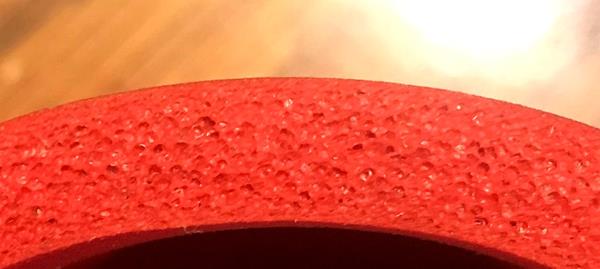
When scuba diving started becoming popular, foamed neoprene made by injecting gas in the manufacturing process was employed for its flexibility and insulating qualities. Closed-cell foamed neoprene, technically called “expanded neoprene” in the industry, consists of tiny nitrogen or carbon dioxide gas bubbles and will compress and rebound based on the pressure exerted on them. That is why you tend to get “heavier” when you descend wearing a wetsuit. The cells get compressed, resulting in your overall volume reducing. With less volume, you displace less seawater and you will more easily sink.
Over multiple dives, some of the neoprene cells compress but do not revert to their original volume. Additionally, some of the cells burst due to your movements while wearing the suit and to improper storage, losing their insulating property. Exposure to sunlight is also damaging to the neoprene and is impossible to completely avoid. That is why your wetsuit “wears out” over time.
How long will a wetsuit last? Answers vary, depending on the quality of the underlying neoprene and the number of dives logged with the suit. Generally, a wetsuit will be good for 200 to 400 dives, or about five to ten years for the average diver. Can you still wear it? Absolutely! But keep in mind that it just won’t keep you as warm as when it was new, nor will it look as good as a newer suit. Style is everything!
Members who have a credit from 2018 have the option to either request a full refund or apply $35 of their refund toward the discounted rate for their 2019 membership. In the latter case, the balance will be refunded and a check will be mailed to the address of record in our membership file. If you wish to request a full refund, call Lon at 305-251-4975. No action is required if you want $35 applied to your 2019 membership or to extend your membership one year.
Another great solution for capturing ocean garbage, this time from Guatemala. The Guatemalans use biofences. These are “fences” made out of plastic bottles (capped so they float) wrapped in a net. The net is then strung along areas where trash accumulates. This stops the floating trash and gathers it in one area. It is then collected by local people daily and sent to re-cycling centers.
Ten biofences are in use so far. The government is considering upgrading them and expanding their use. The main area for use is at the mouth of rivers. This collects the trash before it enters the ocean. Even though it is being done in Guatemala, the beaches in Honduras are notable cleaner. The trash is prevented from being swept into the ocean and carried to other places.
Ten isn’t a lot but it is already making a notable difference. Imagine what a 1,000 could do. It also employs people that ordinarily don’t have jobs. More importantly is that it shows these people how keeping the beaches clean is their responsibility. This results in less overall trash being deposited into the water stream. I would call this a win-win situation.
![]()
Want your newsletter delivered via snail-mail? Contact the webmaster and request a printed copy. Be sure to put "Active Divers Newsletter" in the subject.
![]()
If so, please email or call us with your
current information. You may send an email to: Dr. Dan Baeza,
Membership Chair at: ActiveDiversInfo@gmail.com.
You can also call Dan at 954-260-8225 and leave a message with your
new contact information.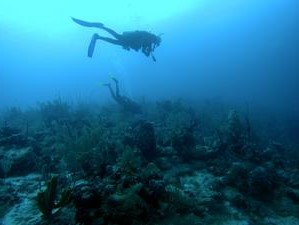
Active Divers T-Shirts For Sale
Show your pride in the best dive club anywhere! Sizes small, medium, large, xlarge, xxlarge. Some tank tops available also. All shirts are $10 each. CALL LON AT 305-251-4975 AND PLACE YOUR ORDER TODAY!. Lon will deliver it to you on your next dive
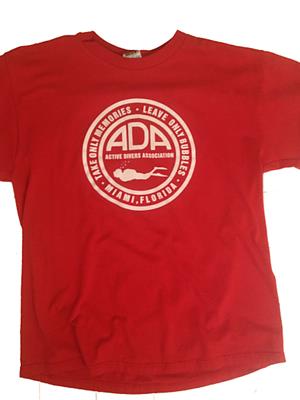
It’s the site of the famous chumsicle reef shark dives of the ‘90s and later for its bull shark beach where bull sharks aggregated in shallow water and shark behaviorist Dr. Erik Ritter famously got badly bitten in front of TV cameras. The resort on the northernmost island in the Abaco chain, a little more than 100 miles from West Palm, is set to re-open, thanks to new owners Texana Carl and Gigi Allen. Deserted and abandoned after two successive hurricanes in 2004, the hotel building and marina will be replaced. Hopefully, scuba diving will be reinstated too.
The resort is tentatively slated to reopen in April or May, 2020.